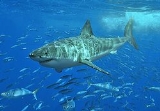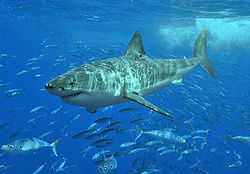
1992 Cageless shark-diving expedition
Encyclopedia

Great white shark
The great white shark, scientific name Carcharodon carcharias, also known as the great white, white pointer, white shark, or white death, is a large lamniform shark found in coastal surface waters in all major oceans. It is known for its size, with the largest individuals known to have approached...
s. It contributed to changing public opinions about the supposed ferocity of these animals.
History
In January 1992, during the filming of the National Geographic documentary Blue Wilderness, and after surface testing of the prototype "Shark PodProtective Oceanic Device
The Protective Oceanic Device is a portable device that emits an electromagnetic field around a person protecting against sharks. The POD was developed by Natal Sharks Board, and was the first successful electronic shark repellent for scuba divers....
" (now Shark Shield) for the Natal Sharks Board, amongst several large great white sharks swimming around the boat at Dyer Island, Western Cape
Western Cape
The Western Cape is a province in the south west of South Africa. The capital is Cape Town. Prior to 1994, the region that now forms the Western Cape was part of the much larger Cape Province...
, South Africa
South Africa
The Republic of South Africa is a country in southern Africa. Located at the southern tip of Africa, it is divided into nine provinces, with of coastline on the Atlantic and Indian oceans...
, four scuba divers: Ron & Valerie Taylor
Ron & Valerie Taylor
Ron Taylor and Valerie Taylor are prominent Australian shark and underwater experts. Their expertise has been called upon for films such as Jaws, Orca and Sky Pirates....
(notable Australian pioneers of underwater exploration and film-makers), good friend George Askew (Pioneer South African diver and photographer), and Piet van der Walt
Piet van der Walt
Piet van der Walt is a Namibian businessperson and politician. A White Afrikaner Namibian, van der Walt began associating with SWAPO in a business capacity following independence in 1990. He was placed on the parliamentary list for SWAPO at number 42 prior to the 2009 National Assembly election and...
, (the latter two are pioneers of the South African cage diving industry in 1989), carried out the world's first dive amongst these animals without a safety cage—which had been lost in a storm.
The Prototype Valerie is seen wearing during this dive was a dummy for continuity and afforded the divers no protection.
The Taylors and Askew, recognised shark experts, were testing their hypotheses, based on many years of experiences with sharks, that these animals had a much fiercer reputation than they deserved. In fact Askew had proposed, in an article entitled "Myth or Maneater?", published in the UK magazine Underwater World in 1978, that Great Whites did not deserve the horrific image and reputation that Jaws author Peter Benchley
Peter Benchley
Peter Bradford Benchley was an American author, best known for his novel Jaws and its subsequent film adaptation, the latter co-written by Benchley and directed by Steven Spielberg...
and film director Steven Spielberg
Steven Spielberg
Steven Allan Spielberg KBE is an American film director, screenwriter, producer, video game designer, and studio entrepreneur. In a career of more than four decades, Spielberg's films have covered many themes and genres. Spielberg's early science-fiction and adventure films were seen as an...
had imprinted in peoples minds. He postulated that if the Great White knew you were aware of its presence you had a pretty good chance of not being attacked, as they rely on stealth and surprise when attacking.
He wrote two more articles on the same thread in 1983 and 1991—and then went on to prove that point with the historic dive.
The divers had several timid encounters after a long wait and this ground-breaking "Underwater Everest" conquest convincingly destroyed the myth of the Great White being a mindless Monster, an eating machine and changed people's perceptions of these animals forever.
It opened the door to more free swimming close encounters by later divers.
The Taylors felt that the Australian sharks have a slightly different disposition to South African ones, but as it is now known that great whites swim between South Africa and Australia, this may be questionable.
Askew had encountered Great White Sharks three times previously over the years whilst spearfishing—the first being in 1960 when in those days it was thought that meeting one was sure death. Because he was never attacked his fascination grew.
The Taylors had many years before had twice released Great Whites trapped in ropes. They were never harassed despite touching the animals.
Impact
The divers found the sharks were actually very timid and difficult to approach, although just before the dive when Ron Taylor and Askew were kneeling on the dive platform a few centimetres / inches above water filming, with their hands in the water, a premonition made Askew get up.As he did so and stepped back, a 4 metre/13ft Great White slid onto the platform.
It would have taken his camera and arms, and maybe pulled him in if he had not got up.
It stopped 75 mm/3inches from his foot before sliding back. It made no attempt to snap or lunge at him.
Askew sees that incident as pure opportunism and not savagery.
The consequences of that first historic dive were the close encounters that have shown the world that great whites are not there to devour people but can be quite friendly.
Since this dive a few intrepid souls have done cageless dives—even hitching rides on their dorsal fins and touching them underwater.

